Configurazione di ASA-ASA Dynamic-to-Static IKEv1/IPsec
Opzioni per il download
Linguaggio senza pregiudizi
La documentazione per questo prodotto è stata redatta cercando di utilizzare un linguaggio senza pregiudizi. Ai fini di questa documentazione, per linguaggio senza di pregiudizi si intende un linguaggio che non implica discriminazioni basate su età, disabilità, genere, identità razziale, identità etnica, orientamento sessuale, status socioeconomico e intersezionalità. Le eventuali eccezioni possono dipendere dal linguaggio codificato nelle interfacce utente del software del prodotto, dal linguaggio utilizzato nella documentazione RFP o dal linguaggio utilizzato in prodotti di terze parti a cui si fa riferimento. Scopri di più sul modo in cui Cisco utilizza il linguaggio inclusivo.
Informazioni su questa traduzione
Cisco ha tradotto questo documento utilizzando una combinazione di tecnologie automatiche e umane per offrire ai nostri utenti in tutto il mondo contenuti di supporto nella propria lingua. Si noti che anche la migliore traduzione automatica non sarà mai accurata come quella fornita da un traduttore professionista. Cisco Systems, Inc. non si assume alcuna responsabilità per l’accuratezza di queste traduzioni e consiglia di consultare sempre il documento originale in inglese (disponibile al link fornito).
Sommario
Introduzione
In questo documento viene descritto come abilitare l'ASA per accettare connessioni VPN IPsec dinamiche da sito a sito da qualsiasi peer dinamico.
Prerequisiti
Requisiti
Cisco raccomanda la conoscenza di questo argomento:
- ASA (Adaptive Security Appliance)
Componenti usati
Per questo documento, è stato usato il software firewall Cisco ASA (5510 e 5520) versione 9.x e successive.
Le informazioni discusse in questo documento fanno riferimento a dispositivi usati in uno specifico ambiente di emulazione. Su tutti i dispositivi menzionati nel documento la configurazione è stata ripristinata ai valori predefiniti. Se la rete è operativa, valutare attentamente eventuali conseguenze derivanti dall'uso dei comandi.
Premesse
In questo documento viene descritto come abilitare l'appliance ASA (Adaptive Security Appliance) per accettare connessioni VPN IPsec dinamiche da sito a sito da qualsiasi peer dinamico (in questo caso, ASA). Come mostrato nel diagramma reticolare di questo documento, il tunnel IPsec viene stabilito solo quando il tunnel viene avviato dall'estremità remota dell'appliance ASA. L'appliance ASA centrale non può avviare un tunnel VPN a causa della configurazione IPsec dinamica. L'indirizzo IP di Remote-ASA è sconosciuto.
Configurare l'appliance ASA centrale in modo che accetti dinamicamente le connessioni da un indirizzo IP con caratteri jolly (0.0.0.0/0) e da una chiave precondivisa con caratteri jolly. Remote-ASA viene quindi configurato per crittografare il traffico dalle subnet locali a Central-ASA come specificato dall'elenco degli accessi crittografici. Entrambe le parti eseguono l'esenzione NAT (Network Address Translation) per ignorare NAT per il traffico IPsec.
Configurazione
Nota: per ulteriori informazioni sui comandi menzionati in questa sezione, usare lo strumento di ricerca dei comandi. Solo gli utenti Cisco registrati possono accedere agli strumenti e alle informazioni interne di Cisco.
Esempio di rete

Configurazione ASDM
Central-ASA (peer statico)
Su un'ASA con indirizzo IP statico, configurare la VPN in modo che accetti connessioni dinamiche da un peer sconosciuto mentre autentica il peer usando una chiave già condivisa IKEv1:
- Scegliere Configurazione > VPN da sito a sito > Avanzate > Mappe crittografiche. La finestra visualizza l'elenco delle voci della mappa crittografica già presenti (se presenti). Poiché l'ASA non sa quale sia l'indirizzo IP del peer, per accettare la connessione, è necessario configurare la mappa dinamica con il set di trasformazioni corrispondente (proposta IPSec). Fare clic su Add.
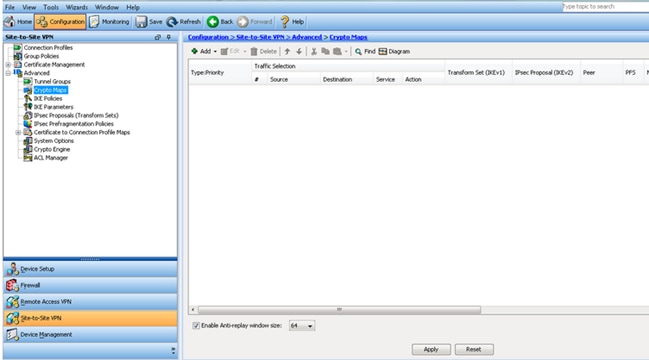
- Nella finestra Crea regola IPSec, dalla scheda Criterio tunnel (mappa crittografica) - Impostazioni di base, selezionare l'esterno dall'elenco a discesa Interfaccia e dinamico dall'elenco a discesa Tipo di criterio. Nel campo Priorità, assegnare la priorità a questa voce se in Mappa dinamica sono presenti più voci. A questo punto, fare clic su Select (Seleziona) accanto al campo IKE v1 IPsec Project (Proposta IPSec) per selezionare la proposta IPSec.
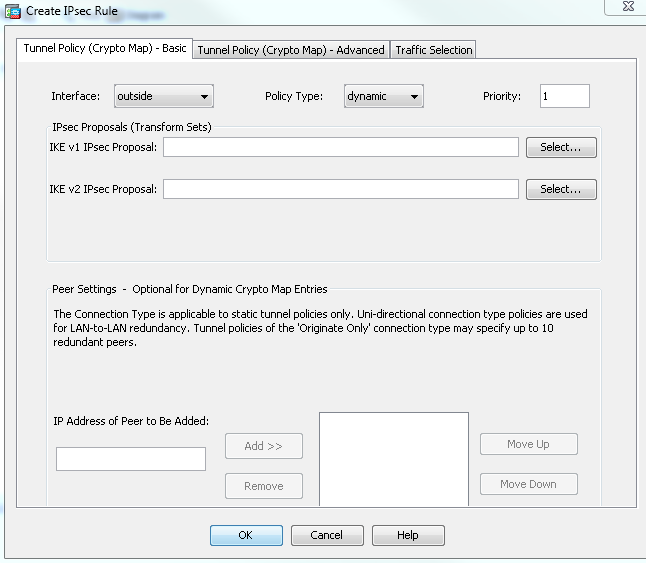
- Quando viene visualizzata la finestra di dialogo Seleziona proposte IPSec (set di trasformazioni), scegliere una delle proposte IPSec correnti o fare clic su Aggiungi per crearne una nuova e utilizzarla allo stesso modo. Al termine, fare clic su OK.

- Dalla scheda Criteri tunnel (mappa crittografica)-Avanzate, selezionare la casella di controllo Abilita NAT-T (obbligatorio se uno dei peer si trova dietro un dispositivo NAT) e la casella di controllo Abilita Reverse Route Injection. Quando il tunnel VPN arriva per il peer dinamico, ASA installa un percorso dinamico per la rete VPN remota negoziata che punta all'interfaccia VPN.
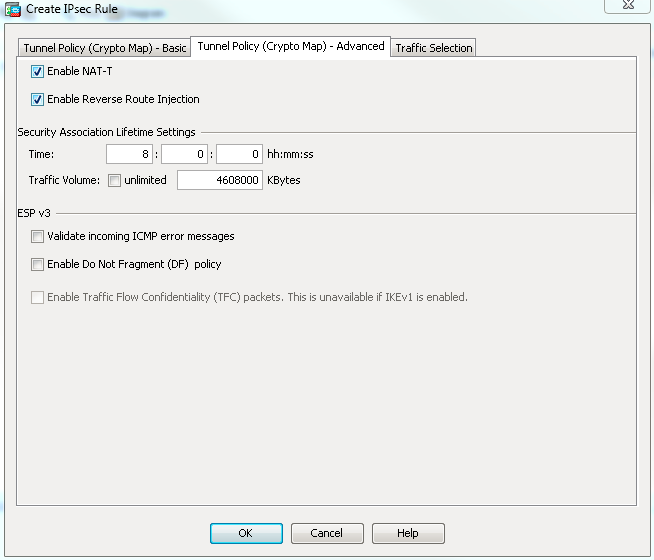
In alternativa, dalla scheda Selezione traffico è possibile anche definire il traffico VPN interessante per il peer dinamico e fare clic su OK.
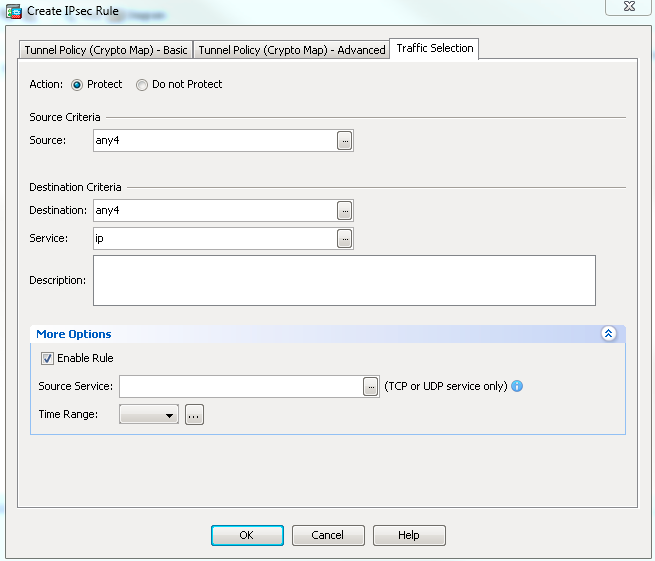
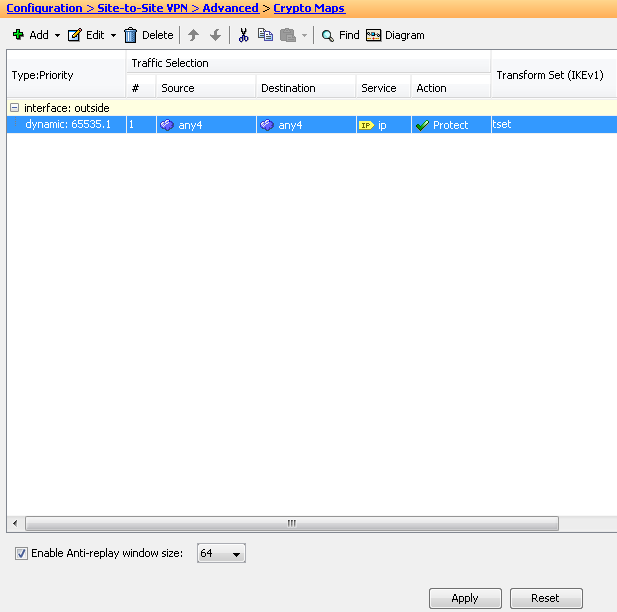
Come accennato in precedenza, poiché l'appliance ASA non dispone di informazioni sull'indirizzo IP dinamico remoto del peer, la richiesta di connessione sconosciuta viene inoltrata in DefaultL2LGroup esistente sull'appliance ASA per impostazione predefinita. Affinché l'autenticazione riesca, la chiave già condivisa (cisco123 in questo esempio) configurata sul peer remoto deve corrispondere a quella in DefaultL2LGroup.
- Scegliere Configurazione > VPN da sito a sito > Avanzate > Gruppi di tunnel, selezionare DefaultL2LGroup, fare clic su Modifica e configurare la chiave precondivisa desiderata. Al termine, fare clic su OK.
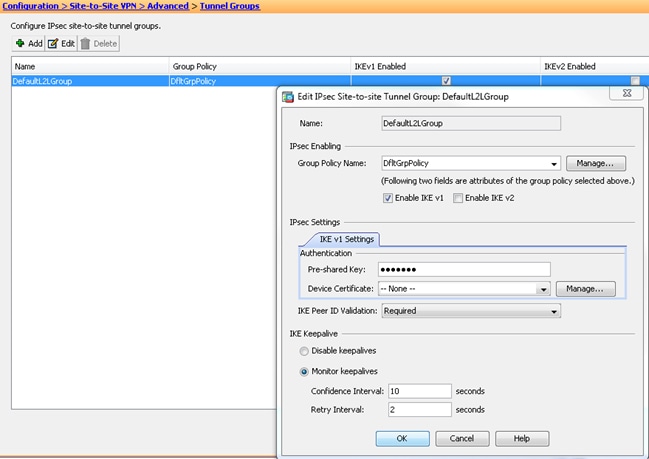
Nota: in questo modo viene creata una chiave già condivisa con caratteri jolly sul peer statico (Central-ASA). Tutti i dispositivi/peer che conoscono questa chiave precondivisa e le relative proposte corrispondenti possono stabilire un tunnel VPN e accedere alle risorse tramite VPN. Verificare che la chiave già condivisa non sia condivisa con entità sconosciute e che non sia facile da indovinare.
- Scegliere Configurazione > VPN da sito a sito > Criteri di gruppo e selezionare i criteri di gruppo desiderati (in questo caso i criteri di gruppo predefiniti). Fare clic su Modifica e modificare i Criteri di gruppo nella finestra di dialogo Modifica Criteri di gruppo interni. Al termine, fare clic su OK.
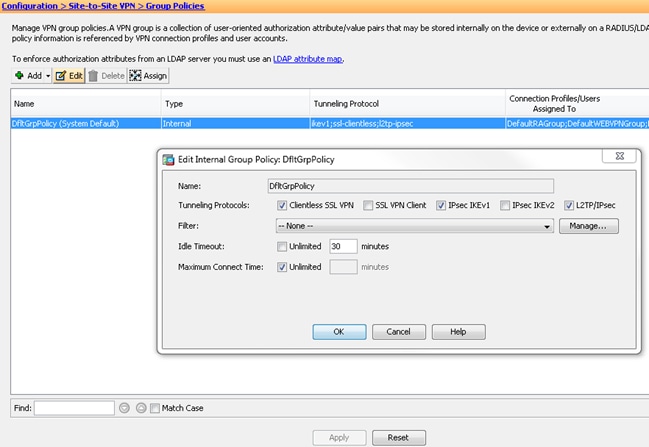
- Scegliere Configurazione > Firewall > Regole NAT e nella finestra Aggiungi regola NAT configurare una regola no nat (NAT-FREE) per il traffico VPN. Al termine, fare clic su OK.
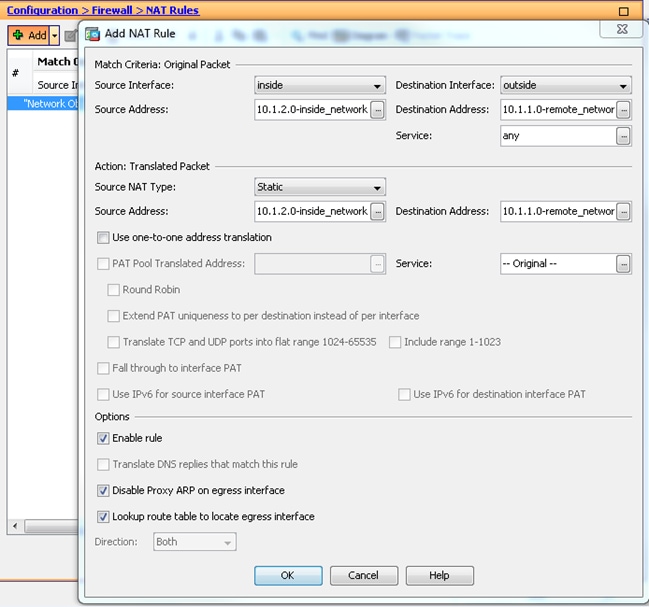
Remote-ASA (Dynamic Peer)
- Scegliere Procedure guidate > Creazioni guidate VPN > Creazione guidata VPN da sito a sito una volta che l'applicazione ASDM si connette all'ASA.

- Fare clic su Next (Avanti).

- Per specificare l'indirizzo IP esterno del peer remoto, selezionare external (esterno) dall'elenco a discesa VPN Access Interface (Interfaccia di accesso VPN). Selezionare l'interfaccia (WAN) a cui applicare la mappa crittografica. Fare clic su Next (Avanti).

- Specificare gli host/le reti a cui deve essere consentito il passaggio attraverso il tunnel VPN. In questo passaggio, è necessario fornire le reti locali e le reti remote per il tunnel VPN. Fare clic sui pulsanti accanto ai campi Rete locale e Rete remota e scegliere l'indirizzo in base alle esigenze. Al termine, fare clic su Avanti.
T

- Immettere le informazioni di autenticazione da utilizzare, ovvero la chiave già condivisa in questo esempio. La chiave già condivisa utilizzata in questo esempio è cisco123. Il nome del gruppo di tunnel è l'indirizzo IP peer remoto predefinito se si configura una VPN da LAN a LAN (L2L).

O
È possibile personalizzare la configurazione per includere i criteri IKE e IPsec desiderati. È necessario che tra i peer sia presente almeno un criterio di corrispondenza:
- Nella scheda Metodi di autenticazione, immettere la chiave già condivisa IKE versione 1 nel campo Chiave già condivisa. Nell'esempio, questo valore è cisco123.
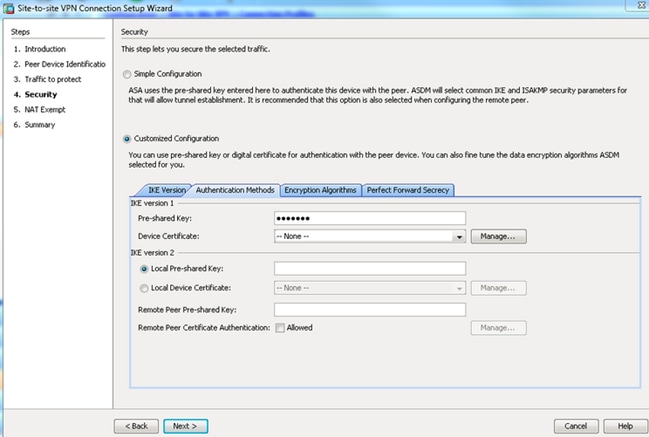
- Fare clic sulla scheda Algoritmi di crittografia.
- Nella scheda Metodi di autenticazione, immettere la chiave già condivisa IKE versione 1 nel campo Chiave già condivisa. Nell'esempio, questo valore è cisco123.
- Fare clic su Gestisci accanto al campo Criterio IKE, fare clic su Aggiungi e configurare un criterio IKE personalizzato (fase 1). Al termine, fare clic su OK.
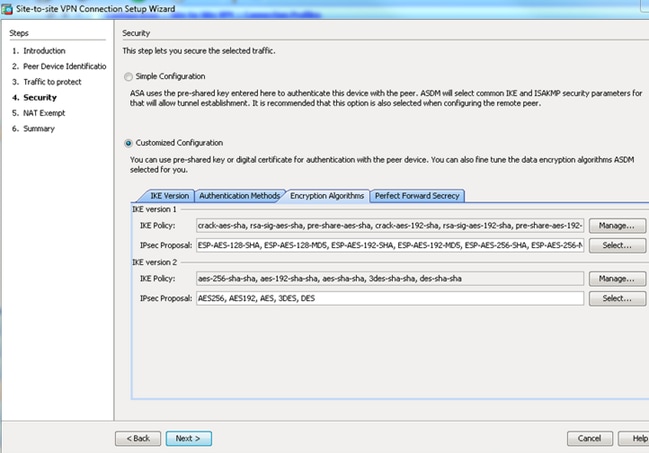
- Fare clic su Select (Seleziona) accanto al campo IPsec Project (Proposta IPSec), quindi selezionare la proposta IPSec desiderata. Al termine, fare clic su Avanti.
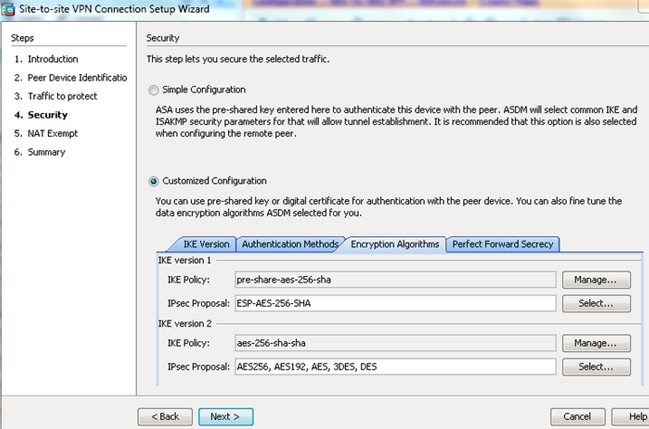
Facoltativamente, è possibile passare alla scheda Perfect Forward Secrecy e selezionare la casella di controllo Abilita Perfect Forward Secrecy (PFS). Al termine, fare clic su Avanti.

- Per evitare che il traffico del tunnel venga attivato da Network Address Translation, selezionare la casella di controllo Esenzione host/rete lato ASA dalla conversione degli indirizzi. Per impostare l'interfaccia in cui è possibile raggiungere la rete locale, selezionare local o inside (locale) dall'elenco a discesa. Fare clic su Next (Avanti).

- ASDM visualizza un riepilogo della VPN appena configurata. Verificare e fare clic su Fine.
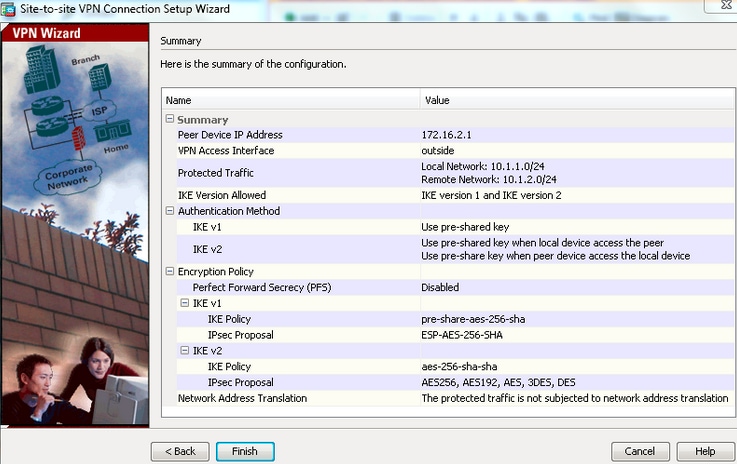
Configurazione dalla CLI
Configurazione ASA centrale (peer statico)
- Configurare una regola NO-NAT/NAT-EXCEPTION per il traffico VPN come mostrato nell'esempio:
object network 10.1.1.0-remote_network
subnet 10.1.1.0 255.255.255.0
object network 10.1.2.0-inside_network
subnet 10.1.2.0 255.255.255.0
nat (inside,outside) source static 10.1.2.0-inside_network 10.1.2.0-inside_network
destination static 10.1.1.0-remote_network 10.1.1.0-remote_network
no-proxy-arp route-lookup - Configurare la chiave già condivisa in DefaultL2LGroup per autenticare qualsiasi peer remoto Dynamic-L2L:
tunnel-group DefaultL2LGroup ipsec-attributes
ikev1 pre-shared-key cisco123 - Definire la policy per la fase 2/ISAKMP:
crypto ikev1 policy 10
authentication pre-share
encryption aes-256
hash sha
group 2
lifetime 86400 - Definire il set di trasformazioni/criterio IPSec per la fase 2:
crypto ipsec ikev1 transform-set tset esp-aes-256 esp-sha-hmac
- Configurare la mappa dinamica con i seguenti parametri:
- Insieme di trasformazioni richiesto
- Abilita Reverse Route Injection (RRI), che consente a Security Appliance di ottenere informazioni di routing per i client connessi (facoltativo)
crypto dynamic-map outside_dyn_map 1 set ikev1 transform-set tset
crypto dynamic-map outside_dyn_map 1 set reverse-route - Associare la mappa dinamica alla mappa crittografica, applicare la mappa crittografica e abilitare ISAKMP/IKEv1 sull'interfaccia esterna:
crypto map outside_map 65535 ipsec-isakmp dynamic outside_dyn_map
crypto map outside_map interface outside
crypto ikev1 enable outside
Remote-ASA (Dynamic Peer)
- Configurare una regola di esenzione NAT per il traffico VPN:
object network 10.1.1.0-inside_network
subnet 10.1.1.0 255.255.255.0
object network 10.1.2.0-remote_network
subnet 10.1.2.0 255.255.255.0
nat (inside,outside) source static 10.1.1.0-inside_network 10.1.1.0-inside_network
destination static 10.1.2.0-remote_network 10.1.2.0-remote_network
no-proxy-arp route-lookup - Configurare un gruppo di tunnel per un peer VPN statico e una chiave già condivisa.
tunnel-group 172.16.2.1 type ipsec-l2l
tunnel-group 172.16.2.1 ipsec-attributes
ikev1 pre-shared-key cisco123 - Definizione delle regole PHASE-1/ISAKMP:
crypto ikev1 policy 10
authentication pre-share
encryption aes-256
hash sha
group 2
lifetime 86400 - Definire un set di trasformazioni/criterio IPSec per la fase 2:
crypto ipsec ikev1 transform-set ESP-AES-256-SHA esp-aes-256 esp-sha-hmac
- Configurare un elenco degli accessi che definisca il traffico/la rete VPN di interesse:
access-list outside_cryptomap extended permit ip object
10.1.1.0-inside_network object 10.1.2.0-remote_network - Configurare la mappa crittografica statica con questi parametri:
- Access-list VPN/crittografica
- Indirizzo IP peer IPsec remoto
- Insieme di trasformazioni richiesto
crypto map outside_map 1 match address outside_cryptomap
crypto map outside_map 1 set peer 172.16.2.1
crypto map outside_map 1 set ikev1 transform-set ESP-AES-256-SHA - Applicare la mappa crittografica e abilitare ISAKMP/IKEv1 sull'interfaccia esterna:
crypto map outside_map interface outside
crypto ikev1 enable outside
Verifica
Per verificare che la configurazione funzioni correttamente, consultare questa sezione.
Lo strumento Output Interpreter supporta alcuni comandi show. Usare lo strumento Output Interpreter per visualizzare un'analisi dell'output del comando show.

Nota: solo gli utenti Cisco registrati possono accedere alle informazioni e agli strumenti Cisco interni.
- show crypto isakmp sa: visualizza tutte le associazioni di sicurezza (SA) IKE correnti in un peer.
- show crypto ipsec sa: visualizza tutte le SA IPsec correnti.
In questa sezione viene mostrato un esempio di verifica dei due appliance ASA.
ASA centrale
Central-ASA#show crypto isakmp sa
IKEv1 SAs:
Active SA: 1
Rekey SA: 0 (A tunnel will report 1 Active and 1 Rekey SA during rekey)
Total IKE SA: 1
1 IKE Peer: 172.16.1.1
Type : L2L Role : responder
Rekey : no State : MM_ACTIVE
Central-ASA# show crypto ipsec sa
interface: outside
Crypto map tag: outside_dyn_map, seq num: 1, local addr: 172.16.2.1
local ident (addr/mask/prot/port): (10.1.2.0/255.255.255.0/0/0)
remote ident (addr/mask/prot/port): (10.1.1.0/255.255.255.0/0/0)
current_peer: 172.16.1.1
#pkts encaps: 4, #pkts encrypt: 4, #pkts digest: 4
#pkts decaps: 4, #pkts decrypt: 4, #pkts verify: 4
#pkts compressed: 0, #pkts decompressed: 0
#pkts not compressed: 4, #pkts comp failed: 0, #pkts decomp failed: 0
#pre-frag successes: 0, #pre-frag failures: 0, #fragments created: 0
#PMTUs sent: 0, #PMTUs rcvd: 0, #decapsulated frgs needing reassembly: 0
#TFC rcvd: 0, #TFC sent: 0
#Valid ICMP Errors rcvd: 0, #Invalid ICMP Errors rcvd: 0
#send errors: 0, #recv errors: 0
local crypto endpt.: 172.16.2.1/0, remote crypto endpt.: 172.16.1.1/0
path mtu 1500, ipsec overhead 74(44), media mtu 1500
PMTU time remaining (sec): 0, DF policy: copy-df
ICMP error validation: disabled, TFC packets: disabled
current outbound spi: 30D071C0
current inbound spi : 38DA6E51
inbound esp sas:
spi: 0x38DA6E51 (953839185)
transform: esp-aes-256 esp-sha-hmac no compression
in use settings ={L2L, Tunnel, IKEv1, }
slot: 0, conn_id: 28672, crypto-map: outside_dyn_map
sa timing: remaining key lifetime (kB/sec): (3914999/28588)
IV size: 16 bytes
replay detection support: Y
Anti replay bitmap:
0x00000000 0x0000001F
outbound esp sas:
spi: 0x30D071C0 (818966976)
transform: esp-aes-256 esp-sha-hmac no compression
in use settings ={L2L, Tunnel, IKEv1, }
slot: 0, conn_id: 28672, crypto-map: outside_dyn_map
sa timing: remaining key lifetime (kB/sec): (3914999/28588)
IV size: 16 bytes
replay detection support: Y
Anti replay bitmap:
0x00000000 0x00000001
Remote-ASA
Remote-ASA#show crypto isakmp sa
IKEv1 SAs:
Active SA: 1
Rekey SA: 0 (A tunnel will report 1 Active and 1 Rekey SA during rekey)
Total IKE SA: 1
1 IKE Peer: 172.16.2.1
Type : L2L Role : initiator
Rekey : no State : MM_ACTIVE
Remote-ASA#show crypto ipsec sa
interface: outside
Crypto map tag: outside_map, seq num: 1, local addr: 172.16.1.1
access-list outside_cryptomap extended permit ip 10.1.1.0
255.255.255.0 10.1.2.0 255.255.255.0
local ident (addr/mask/prot/port): (10.1.1.0/255.255.255.0/0/0)
remote ident (addr/mask/prot/port): (10.1.2.0/255.255.255.0/0/0)
current_peer: 172.16.2.1
#pkts encaps: 4, #pkts encrypt: 4, #pkts digest: 4
#pkts decaps: 4, #pkts decrypt: 4, #pkts verify: 4
#pkts compressed: 0, #pkts decompressed: 0
#pkts not compressed: 4, #pkts comp failed: 0, #pkts decomp failed: 0
#pre-frag successes: 0, #pre-frag failures: 0, #fragments created: 0
#PMTUs sent: 0, #PMTUs rcvd: 0, #decapsulated frgs needing reassembly: 0
#TFC rcvd: 0, #TFC sent: 0
#Valid ICMP Errors rcvd: 0, #Invalid ICMP Errors rcvd: 0
#send errors: 0, #recv errors: 0
local crypto endpt.: 172.16.1.1/0, remote crypto endpt.: 172.16.2.1/0
path mtu 1500, ipsec overhead 74(44), media mtu 1500
PMTU time remaining (sec): 0, DF policy: copy-df
ICMP error validation: disabled, TFC packets: disabled
current outbound spi: 38DA6E51
current inbound spi : 30D071C0
inbound esp sas:
spi: 0x30D071C0 (818966976)
transform: esp-aes-256 esp-sha-hmac no compression
in use settings ={L2L, Tunnel, IKEv1, }
slot: 0, conn_id: 8192, crypto-map: outside_map
sa timing: remaining key lifetime (kB/sec): (4373999/28676)
IV size: 16 bytes
replay detection support: Y
Anti replay bitmap:
0x00000000 0x0000001F
outbound esp sas:
spi: 0x38DA6E51 (953839185)
transform: esp-aes-256 esp-sha-hmac no compression
in use settings ={L2L, Tunnel, IKEv1, }
slot: 0, conn_id: 8192, crypto-map: outside_map
sa timing: remaining key lifetime (kB/sec): (4373999/28676)
IV size: 16 bytes
replay detection support: Y
Anti replay bitmap:
0x00000000 0x00000001
Risoluzione dei problemi
Le informazioni contenute in questa sezione permettono di risolvere i problemi relativi alla configurazione.
Lo strumento Output Interpreter supporta alcunishow comandi. Usare lo strumento Output Interpreter per visualizzare un'analisi dell'output delshow comando.

Nota: solo gli utenti Cisco registrati possono accedere alle informazioni e agli strumenti Cisco interni.

Nota: consultare le informazioni importanti sui comandi di debug prima di usare i comandi di debug.
Utilizzare i seguenti comandi come illustrato:
clear crypto ikev1 sa <peer IP address>
Clears the Phase 1 SA for a specific peer.
Attenzione: il comandoclear crypto isakmp saè intrusivo in quanto cancella tutti i tunnel VPN attivi.
Nel software PIX/ASA versione 8.0(3) e successive, una singola associazione di protezione IKE può essere cancellata usando il comando clear crypto isakmp sa<peer ip address>. Nelle versioni software precedenti alla 8.0(3), usare il comando vpn-sessiondb logoff tunnel-group <tunnel-group-name> per cancellare le associazioni di sicurezza IKE e IPsec per un singolo tunnel.
Remote-ASA#vpn-sessiondb logoff tunnel-group 172.16.2.1
Do you want to logoff the VPN session(s)? [confirm]
INFO: Number of sessions from TunnelGroup "172.16.2.1" logged off : 1
clear crypto ipsec sa peer <peer IP address>
!!! Clears the required Phase 2 SA for specific peer.
debug crypto condition peer < Peer address>
!!! Set IPsec/ISAKMP debug filters.
debug crypto isakmp sa <debug level>
!!! Provides debug details of ISAKMP SA negotiation.
debug crypto ipsec sa <debug level>
!!! Provides debug details of IPsec SA negotiations
undebug all
!!! To stop the debugs
Debug utilizzati:
debug cry condition peer <remote peer public IP>
debug cry ikev1 127
debug cry ipsec 127
Remote-ASA (iniziatore)
Immettere questo comando packet-tracer per avviare il tunnel:
Remote-ASA#packet-tracer input inside icmp 10.1.1.10 8 0 10.1.2.10 detailed
IPSEC(crypto_map_check)-3: Checking crypto map outside_map 1: matched.
Jan 19 22:00:06 [IKEv1 DEBUG]Pitcher: received a key acquire message, spi 0x0
IPSEC(crypto_map_check)-3: Looking for crypto map matching 5-tuple:
Prot=1, saddr=10.1.1.10, sport=0, daddr=10.1.2.10, dport=0
IPSEC(crypto_map_check)-3: Checking crypto map outside_map 1: matched.
Jan 19 22:00:06 [IKEv1]IP = 172.16.2.1, IKE Initiator: New Phase 1, Intf
inside, IKE Peer 172.16.2.1 local Proxy Address 10.1.1.0, remote Proxy Address
10.1.2.0, Crypto map (outside_map)
:
.
Jan 19 22:00:06 [IKEv1]IP = 172.16.2.1, IKE_DECODE SENDING Message (msgid=0)
with payloads : HDR + SA (1) + VENDOR (13) + VENDOR (13) + VENDOR (13) +
VENDOR (13) + NONE (0) total length : 172
Jan 19 22:00:06 [IKEv1]IP = 172.16.2.1, IKE_DECODE RECEIVED Message (msgid=0)
with payloads : HDR + SA (1) + VENDOR (13) + VENDOR (13) + NONE (0)
total length : 132
:
.
Jan 19 22:00:06 [IKEv1]IP = 172.16.2.1, IKE_DECODE SENDING Message (msgid=0)
with payloads : HDR + KE (4) + NONCE (10) + VENDOR (13) + VENDOR (13) +
VENDOR (13) + VENDOR (13) + NAT-D (20) + NAT-D (20) + NONE (0) total length : 304
Jan 19 22:00:06 [IKEv1]IP = 172.16.2.1, IKE_DECODE RECEIVED Message (msgid=0)
with payloads : HDR + KE (4) + NONCE (10) + VENDOR (13) + VENDOR (13) +
VENDOR (13) + VENDOR (13) + NAT-D (20) + NAT-D (20) + NONE (0) total length : 304
:
.
Jan 19 22:00:06 [IKEv1]IP = 172.16.2.1, Connection landed on tunnel_group 172.16.2.1
<skipped>...
Jan 19 22:00:06 [IKEv1]IP = 172.16.2.1, IKE_DECODE SENDING Message (msgid=0) with
payloads : HDR + ID (5) + HASH (8) + IOS KEEPALIVE (128) + VENDOR (13) +
NONE (0) total length : 96
Jan 19 22:00:06 [IKEv1]Group = 172.16.2.1, IP = 172.16.2.1,
Automatic NAT Detection Status: Remote end is NOT behind a NAT device
This end is NOT behind a NAT device
Jan 19 22:00:06 [IKEv1]IP = 172.16.2.1, IKE_DECODE RECEIVED Message
(msgid=0) with payloads : HDR + ID (5) + HASH (8) + IOS KEEPALIVE (128)
+ VENDOR (13) + NONE (0) total length : 96
Jan 19 22:00:06 [IKEv1 DEBUG]Group = 172.16.2.1, IP = 172.16.2.1, processing ID payload
Jan 19 22:00:06 [IKEv1 DECODE]Group = 172.16.2.1, IP = 172.16.2.1,
ID_IPV4_ADDR ID received 172.16.2.1
:
.
Jan 19 22:00:06 [IKEv1]IP = 172.16.2.1, Connection landed on tunnel_group 172.16.2.1
Jan 19 22:00:06 [IKEv1 DEBUG]Group = 172.16.2.1, IP = 172.16.2.1,
Oakley begin quick mode
Jan 19 22:00:06 [IKEv1]Group = 172.16.2.1, IP = 172.16.2.1, PHASE 1 COMPLETED
Jan 19 22:00:06 [IKEv1 DECODE]Group = 172.16.2.1, IP = 172.16.2.1, IKE Initiator
starting QM: msg id = c45c7b30
:
.
Jan 19 22:00:06 [IKEv1 DEBUG]Group = 172.16.2.1, IP = 172.16.2.1, Transmitting Proxy Id:
Local subnet: 10.1.1.0 mask 255.255.255.0 Protocol 0 Port 0
Remote subnet: 10.1.2.0 Mask 255.255.255.0 Protocol 0 Port 0
:
.
Jan 19 22:00:06 [IKEv1]IP = 172.16.2.1, IKE_DECODE SENDING Message
(msgid=c45c7b30) with payloads : HDR + HASH (8) + SA (1) + NONCE
(10) + ID (5) + ID (5) + NOTIFY (11) + NONE (0) total length : 200
Jan 19 22:00:06 [IKEv1]IP = 172.16.2.1, IKE_DECODE RECEIVED Message
(msgid=c45c7b30) with payloads : HDR + HASH (8) + SA (1) + NONCE (10) +
ID (5) + ID (5) + NONE (0) total length : 172
:
.
Jan 19 22:00:06 [IKEv1 DEBUG]Group = 172.16.2.1, IP = 172.16.2.1, processing ID payload
Jan 19 22:00:06 [IKEv1 DECODE]Group = 172.16.2.1, IP = 172.16.2.1,
ID_IPV4_ADDR_SUBNET ID received--10.1.1.0--255.255.255.0
Jan 19 22:00:06 [IKEv1 DEBUG]Group = 172.16.2.1, IP = 172.16.2.1, processing ID payload
Jan 19 22:00:06 [IKEv1 DECODE]Group = 172.16.2.1, IP = 172.16.2.1,
ID_IPV4_ADDR_SUBNET ID received--10.1.2.0--255.255.255.0
:
.
Jan 19 22:00:06 [IKEv1]Group = 172.16.2.1, IP = 172.16.2.1,
Security negotiation complete for LAN-to-LAN Group (172.16.2.1)
Initiator, Inbound SPI = 0x30d071c0, Outbound SPI = 0x38da6e51
:
.
Jan 19 22:00:06 [IKEv1]IP = 172.16.2.1, IKE_DECODE SENDING Message
(msgid=c45c7b30) with payloads : HDR + HASH (8) + NONE (0) total length : 76
:
.
Jan 19 22:00:06 [IKEv1]Group = 172.16.2.1, IP = 172.16.2.1,
PHASE 2 COMPLETED (msgid=c45c7b30)
Central-ASA (risponditore)
Jan 20 12:42:35 [IKEv1]IP = 172.16.1.1, IKE_DECODE RECEIVED Message (msgid=0)
with payloads : HDR + SA (1) + VENDOR (13) + VENDOR (13) + VENDOR (13) +
VENDOR (13) + NONE (0) total length : 172
:
.
Jan 20 12:42:35 [IKEv1]IP = 172.16.1.1, IKE_DECODE SENDING Message (msgid=0)
with payloads : HDR + SA (1) + VENDOR (13) + VENDOR (13) + NONE (0) total length
:
132
Jan 20 12:42:35 [IKEv1]IP = 172.16.1.1, IKE_DECODE RECEIVED Message (msgid=0)
with payloads : HDR + KE (4) + NONCE (10) + VENDOR (13) + VENDOR (13) + VENDOR (13)
+ VENDOR (13) + NAT-D (20) + NAT-D (20) + NONE (0) total length : 304
:
.
Jan 20 12:42:35 [IKEv1]IP = 172.16.1.1, Connection landed on tunnel_group
DefaultL2LGroup
Jan 20 12:42:35 [IKEv1 DEBUG]Group = DefaultL2LGroup, IP = 172.16.1.1,
Generating keys for Responder...
Jan 20 12:42:35 [IKEv1]IP = 172.16.1.1, IKE_DECODE SENDING Message (msgid=0)
with payloads : HDR + KE (4) + NONCE (10) +
VENDOR (13) + VENDOR (13) + VENDOR (13) + VENDOR (13) + NAT-D (20) + NAT-D (20) +
NONE (0) total length : 304
Jan 20 12:42:35 [IKEv1]IP = 172.16.1.1, IKE_DECODE RECEIVED Message (msgid=0)
with payloads : HDR + ID (5) + HASH (8)
+ IOS KEEPALIVE (128) + VENDOR (13) + NONE (0) total length : 96
Jan 20 12:42:35 [IKEv1 DECODE]Group = DefaultL2LGroup, IP = 172.16.1.1,
ID_IPV4_ADDR ID received 172.16.1.1
:
.
Jan 20 12:42:35 [IKEv1]IP = 172.16.1.1, IKE_DECODE SENDING Message (msgid=0)
with payloads : HDR + ID (5) + HASH (8) + IOS KEEPALIVE (128) +
VENDOR (13) + NONE (0) total length : 96
Jan 20 12:42:35 [IKEv1]Group = DefaultL2LGroup, IP = 172.16.1.1, PHASE 1 COMPLETED
:
.
Jan 20 12:42:35 [IKEv1 DECODE]IP = 172.16.1.1, IKE Responder starting QM:
msg id = c45c7b30
Jan 20 12:42:35 [IKEv1]IP = 172.16.1.1, IKE_DECODE
RECEIVED Message (msgid=c45c7b30) with payloads : HDR + HASH (8) + SA (1) +
NONCE (10) + ID (5) + ID (5) + NOTIFY (11) + NONE (0) total length : 200
:
.
Jan 20 12:42:35 [IKEv1]Group = DefaultL2LGroup, IP = 172.16.1.1, Received remote
IP Proxy Subnet data in ID Payload: Address 10.1.1.0, Mask 255.255.255.0,
Protocol 0, Port 0 :
.
Jan 20 12:42:35 [IKEv1]Group = DefaultL2LGroup,
IP = 172.16.1.1, Received local
IP Proxy Subnet data in ID Payload: Address 10.1.2.0, Mask 255.255.255.0,
Protocol 0, Port 0 Jan 20 12:42:35 [IKEv1 DEBUG]Group = DefaultL2LGroup,
IP = 172.16.1.1, processing notify payload
Jan 20 12:42:35 [IKEv1] Group = DefaultL2LGroup, IP = 172.16.1.1, QM
IsRekeyed old sa not found by addr
Jan 20 12:42:35 [IKEv1]Group = DefaultL2LGroup, IP = 172.16.1.1, Static Crypto Map
check, map outside_dyn_map, seq = 1 is a successful match
Jan 20 12:42:35 [IKEv1]Group = DefaultL2LGroup, IP = 172.16.1.1, IKE
Remote Peer configured for crypto map: outside_dyn_map
:
.
Jan 20 12:42:35 [IKEv1 DEBUG]Group = DefaultL2LGroup, IP = 172.16.1.1,
Transmitting Proxy Id: Remote subnet: 10.1.1.0 Mask 255.255.255.0 Protocol 0 Port 0
Local subnet: 10.1.2.0 mask 255.255.255.0 Protocol 0 Port 0 :
.
Jan 20 12:42:35 [IKEv1]IP = 172.16.1.1, IKE_DECODE SENDING Message (msgid=c45c7b30)
with payloads : HDR + HASH (8) + SA (1) + NONCE (10) + ID (5) + ID (5) + NONE
(0) total length : 172 Jan 20 12:42:35 [IKEv1]IP = 172.16.1.1, IKE_DECODE RECEIVED
Message (msgid=c45c7b30) with payloads : HDR + HASH (8) + NONE (0) total length : 52:
.
Jan 20 12:42:35 [IKEv1]Group = DefaultL2LGroup, IP = 172.16.1.1, Security
negotiation complete for LAN-to-LAN Group (DefaultL2LGroup) Responder,
Inbound SPI = 0x38da6e51, Outbound SPI = 0x30d071c0 :
.
Jan 20 12:42:35 [IKEv1]Group = DefaultL2LGroup, IP = 172.16.1.1,
PHASE 2 COMPLETED (msgid=c45c7b30)
Jan 20 12:42:35 [IKEv1]Group = DefaultL2LGroup, IP = 172.16.1.1, Adding static
route for L2L peer coming in on a dynamic map. address: 10.1.1.0, mask: 255.255.255.0
Informazioni correlate
Cronologia delle revisioni
| Revisione | Data di pubblicazione | Commenti |
|---|---|---|
1.0 |
22-Jun-2015 |
Versione iniziale |
Contributo dei tecnici Cisco
- Tecnici TAC
 Feedback
Feedback